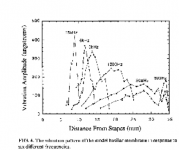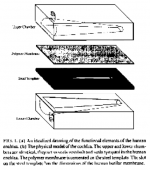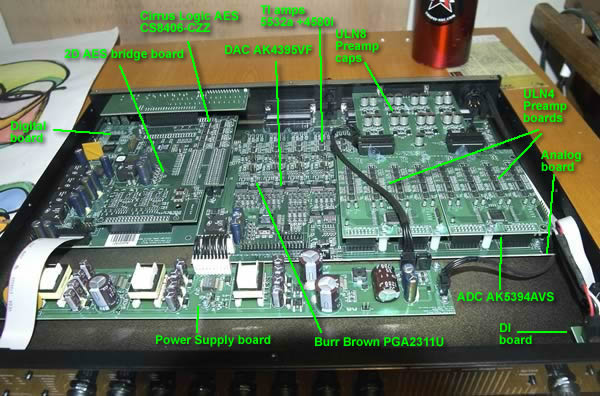I assumed Power ( audible) vs voltage(signal)??Really? I would have thought 80dB. Could you explain to a dummy how you got that number?
Percent to dB Conversion Calculator
bet you can't hear 80 dB down SFDR
I assumed Power ( audible) vs voltage(signal)??
That's the difference. Never occurred to me to use power. Thanks!
Really? I would have thought 80dB. Could you explain to a dummy how you got that number?
Guys that live in the "other" world, Wireless and RF, tend to think in terms of power, not voltage. They always use 10 log ratio, not 20. But for audio voltage measurements, it should be 20 of course.
Life size model of the human cochlea with optical readout
Yes and which one matters????? which one can we actually discern?
Gan Zhou and I with Dana Anderson once wrote a paper "life size model of the human cochlea with optical readout" published in JASA. The physics of the cochlea were amazing; as you probably know up to 500 hz a WKB 1-D approximation modeled cochlear traveling wave response pretty well; the basilar membrane response is really quite broad. Above 500hza 3-D model is required and the traveling wave ( like a Tsunami ) membrane deflection is much more peaked in response. past ~ 3khz the the cochlear pressure response is very peaked and we found 15khz was about 5mm from the stapes, hence the 25khz or so discrimination threshold for lucky individuals.
Sadly we never ran two tone etc. through the lab cochlea but the 1khz and below basilar membrane response seems really broad for a highly discriminating response to say an in phase 500hz and 1khz two tone signal.
above 3-5khz and it would be pretty localized, so I would guess 2nd harmonic 1khz and below would be threshold limited on auditory response
No, believe I can't hear -80 dB 2'nd harmonic of my Pyramid amps on a half of output power (40W), especially when it goes all way down under noise floor when power goes down.
Your optical couplers are fantastic, but THD and dynamic range are quite different things.
Yes and which one matters????? which one can we actually discern?
Gan Zhou and I with Dana Anderson once wrote a paper "life size model of the human cochlea with optical readout" published in JASA. The physics of the cochlea were amazing; as you probably know up to 500 hz a WKB 1-D approximation modeled cochlear traveling wave response pretty well; the basilar membrane response is really quite broad. Above 500hza 3-D model is required and the traveling wave ( like a Tsunami ) membrane deflection is much more peaked in response. past ~ 3khz the the cochlear pressure response is very peaked and we found 15khz was about 5mm from the stapes, hence the 25khz or so discrimination threshold for lucky individuals.
Sadly we never ran two tone etc. through the lab cochlea but the 1khz and below basilar membrane response seems really broad for a highly discriminating response to say an in phase 500hz and 1khz two tone signal.
above 3-5khz and it would be pretty localized, so I would guess 2nd harmonic 1khz and below would be threshold limited on auditory response
Attachments
I agree with you that 100 times difference in voltage levels mean 10 times difference in sound pressure. And my own understanding of audibility of errors goes from other direction than analysis of physical hearing apparatus: perception is more than physics, it is combination of sensory perception and mental image manipulations. And if it grew up during evolution to recognize sounds distorted by physical media, such distortions are perceived as information about sound sources and environment, while distortions added by electronics differs a lot, especially in dynamics.
I agree with you that 100 times difference in voltage levels mean 10 times difference in sound pressure. And my own understanding of audibility of errors goes from other direction than analysis of physical hearing apparatus: perception is more than physics, it is combination of sensory perception and mental image manipulations. And if it grew up during evolution to recognize sounds distorted by physical media, such distortions are perceived as information about sound sources and environment, while distortions added by electronics differs a lot, especially in dynamics.
Totally agree. For example a simple experiment, listen to your favorite music drummer, sax etc. and "close " one ear, I know for me the timbre, "air" , "realism" vastly changes for the worse; ( haven't tried it with headphones though), I have always suspected the "difference" in the sound of amplifiers at moderate volumes has something to do with our sensitivity to lateral phase & amplifier interchannel crosstalk with phase delay; hence the love of dual mono power supplies..
I agree with you that 100 times difference in voltage levels mean 10 times difference in sound pressure.
That leads to confusion too, SPL is dealt with like voltage (mV/PA for instance). If you want real confusion photodiodes are A/W.
It should be 20 for any voltage measurements, because we are actually talking about power. 0.01% (voltage) distortion is -80dB whether audio, RF or anything else. Guys in that other world use 10 or 20, as appropriate, if they know what they are doing.BNFY said:Guys that live in the "other" world, Wireless and RF, tend to think in terms of power, not voltage. They always use 10 log ratio, not 20. But for audio voltage measurements, it should be 20 of course.
A few weeks ago we had a dB argument on a radio forum - I was astonished how confused some people were and how confidently they were wrong; please let's not have one here too.
Guess what opamps are used inside the Metric Halo ULN/LIO-8 "soundcards", to many the most transparent sounding pro-audio interfaces they ever got their hands on.
I see more votes for flat mic-pre to DSP RIAA among its users, many converts from some high-end analog pre-amps.
Yeap, that too.
And they use ye olde NE5532 in there...
Cool, that might explain why they recommend a transformer for MC. I guess everything really does sound the same.
Last edited:
And they use ye olde NE5532 in there...
And is that an SMPSU I spy in there too?
That is because it is wrong; Since it is an audio amplifier I was thinking in percent loudness not voltage ( silly I guess)That's the difference. Never occurred to me to use power. Thanks!
as correctly noted:
Signal Power(v) -> 10Log( v^2) = 20Log(v)
I am going to take back my bet on 80db down single spur, see
Sound level SPL to dB - pressure level sound pressure sound intensity - dB conversion of sound units levels calculating spl sound level calculation air sound units level ratio decibel Pa kPa acoustic energy power convert decibels to pascals audio eng
I used this to calculate:
if the there is 33dB(SPL) (.001Pa) signal sitting on audible noise floor; what would corrresponding main harmonic be? I get:
Signal 69 dB(SPL) & 33dB(SPL) noise spur gives a 80dB "single spur" THD.
If I am rocking out at 105 dB ( when I was seventeen I used my Dad's SPL meter to actually measure that on Aerosmith's "Sweet Emotion" through my Kenwood 40Watt integrated amp &12 inch 3 ways, no wonder the Philips tweeters kept smoking.)
I get 3.55 Pa for a .001 Pa noise floor or -117dB down on the audible noise floor, (not sure I remember worrying about a noise floor back in the seventies
"critically loud" say running say 80 dB(SPL) I get -106 dB actually crosses the audible threshold noise floor.
Hi,
Thank you, but no. These Mozzies are worse than those in West Africa! Probably carry Malaria too (sure killed a lot of Gulag inmates).
Ciao T
Or, go to Siberia during summer, seat on some nice meadow with flowers, look on the water in a lake...
Thank you, but no. These Mozzies are worse than those in West Africa! Probably carry Malaria too (sure killed a lot of Gulag inmates).
Ciao T
"critically loud" say running say 80 dB(SPL) I get -106 dB actually crosses the audible threshold noise floor.
Not quite- audible threshold assumes that there's no other signal present. Bill Waslo did a brilliant demonstration of that- check out the Listener Challenge on his downloads page:
Audio DiffMaker example files
It should be 20 for any voltage measurements,... 0.01% (voltage) distortion is -80dB whether audio, RF or anything else. Guys in that other world use 10 or 20, as appropriate, if they know what they are doing.
Well, I guess my using the word "always" above prompted you. Probably should have stayed with "tend to". When you use transmission lines with 50 or 75 ohm impedance, the predominant units for level are dBm, or dBf, dB referenced to 1 milliwatt, or 1 femtowatt respectively. Clearly, when speaking about watts, this is power. When looking at most RF/Microwave Spectrum Analyzer displays (frequency vs amplitude), the amplitude units to the left will usually be dBm as well.
In audio measurements, we don't worry about standing waves, hence usually no 50 ohm transmission lines, and the most commonly used display on a frequency domain plot (via FFT) is dBV.
So yes, one needs to be careful, as it should be clear, -80 dBm "spurs" or "harmonics" does not mean the same ratio as -80 dBV.
The confusion over sound pressure level (SPL) dB units seem to really get the party going. These dB SPL ratio units should be calculated 20 log (ratio) . I can post links to my Bruel and Kjaer acoustics book scans where this is derived and explained, if people want to see it.
Last edited:
- Status
- Not open for further replies.
- Home
- Member Areas
- The Lounge
- Sound Quality Vs. Measurements



